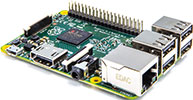
Over recent months, an experiment of sorts has been taking place at a certain barber shop in Melrose; an experiment which has nothing at all to do with its patron’s hairdos. Rather, J’s Barber Shop and Men’s Clothing Shop has been the site for the pilot test of a locally developed innovation in advertising.

Called ‘Jabu’, the device plays videos in a loop, akin to what one will see in most modern shopping malls. It also plays audio, which may not be a new trick, but it does so in a uniquely unobtrusive way, by transmitting on an FM frequency via a built-in, low-power transmitter. This allows consumers who are interested in the advertisement, and armed with a mobile device packing an FM receiver, to tune in and listen.
A Wi-Fi hotspot is another of Jabu’s features, which it creates via a small Android phone that automatically switches off at night and turns on again in the morning to prevent usage by non-customers. But its major draw card, according to its developer Bonele Lusithi, will be its low advertising rates. “If you compare our rates to the likes of some broadcast satellite providers you will see a tremendous difference in pricing,” he says. “For example, a 2 minute advert on that platform will cost you R174 000; Jabu on the other hand, for 5 minutes will cost you just R120 a month.”
Built on Pi
Jabu is a member of the new breed of real-world applications built using so-called ‘maker’ platforms – Raspberry Pi 2, in this case. “I wanted to leverage off of open source technology,” Lusithi says by way of explaining the reason for his choice of using the Pi as a foundation, rather than a fully custom design. “As a software developer, I also wanted to learn a bit about Linux and Raspberry Pi out of curiosity. Raspberry Pi is also one of the cheapest, most reliable and smallest computers ever made, that only requires 5 V to run so it was also perfect for this project. Open source is about sharing knowledge so everything in that space is normally free to download and tweak.
“It was actually a nice challenge to work on Jabu, although the setup was a bit difficult. But as the aim of starting this project was to learn a new tech and use it to make a positive impact on the community, it was also very rewarding when things started coming together. There are many tutorials online from the Pi Community that made some of the tasks easier.”
Jabu uses an operating system that is modified to boot up a program that scans all connected Flash drives for video files and plays them in a loop if found. The Pi outputs Full HD video quality via HDMI, which it outputs to a computer monitor (although newer builds will use 32” LED displays). The program used to do this is an open-source project from Adafruity.
Where to from here?
As to what Jabu’s future has in store, Lusithi says he is putting together all the information about it on a website, including the cost of a unit and also the fee for businesses to advertise. “We have also identified businesses that we will approach that we feel have a lot of customers coming in and staying for long periods of time,” he says. “We will also be approaching government departments (Home Affairs, licensing departments, etc) and proposing a rollout of Jabu at these places.
“There are no set dates for commercial release at the moment and this is due to the fact that Jabu is a product that requires a bit of buy-in from businesses to try this different way of advertising, so we are giving it time to grow. We will however be spending the next three months promoting the service through multiple mediums. We are also currently looking for media organisations to partner with us; at the moment we are in talks with an organisation from the Free State but nothing yet from Gauteng,” Lusithi concludes.
For more information contact Bonele Lusithi, [email protected]

© Technews Publishing (Pty) Ltd | All Rights Reserved